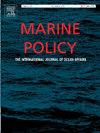西班牙地中海海洋保护区内的捕鱼活动
IF 3.7
2区 社会学
Q2 ENVIRONMENTAL STUDIES
引用次数: 0
摘要
海洋保护区(MPAs)用于生物多样性保护,《生物多样性公约》缔约方同意将其与其他有效的基于区域的保护措施一起使用,到2030年保护30% %的海洋。科学证据表明,最积极的结果取决于全面保护,即禁止所有采掘活动。然而,大多数受到保护的是部分保护,而且往往是不同程度的保护。在这里,我们根据27个西班牙地中海国家和地区指定的海洋保护区的渔业法规评估了保护水平,并确定了部分保护区内允许使用的渔具。防止捕鱼的保护水平是根据海洋保护区边界内允许的渔具数量及其潜在的生态影响来分配的。所包括的海洋保护区覆盖了西班牙地中海总面积的大约0.8 %,其中63 %与自然保护不相容,7 %受到充分或高度保护。我们的研究结果表明,在相同保护水平的部分保护区(即轻度保护区)和区域中,允许年轮的组成存在差异。包括适用于每个海洋保护区的特定渔具限制捕捞条例背后的原因,可以帮助了解每个海洋保护区的背景,并提高海洋保护区的有效性。我们的研究有助于说明西班牙地中海海洋保护的次优现状,以及增加有效保护工作以实现基于区域的保护目标的必要性。本文章由计算机程序翻译,如有差异,请以英文原文为准。
Fishing activities within Spanish marine protected areas in the Mediterranean Sea
Marine protected areas (MPAs) are used for biodiversity conservation and Parties to the Convention on Biological Diversity agreed to use them together with other effective area-based conservation measures to protect 30 % of the ocean by 2030. Scientific evidence shows that most positive outcomes are dependent on full protection, where all extractive activities are banned. Yet, most of what is being protected is under partial protection, with often heterogeneous levels of protection. Here, we assess the protection level based on fishing regulations of 27 Spanish Mediterranean nationally and regionally designated MPAs and identify the fishing gears allowed within the partially protected areas. The level of protection from fishing is assigned based on the number of allowed fishing gears within MPA borders and their potential ecological impact. Approximately 0.8 % of the total area of the Spanish Mediterranean Sea is covered by the included MPAs, of which 63 % is incompatible with the conservation of nature and 7 % is fully or highly protected. Our results show that the composition of allowed gears varies across partially protected areas within the same level of protection (i.e. lightly protected areas) and regions. Including the reasoning behind specific gear restrictions on fishing regulations that apply to each MPA could help to understand the context of each MPA, and improve MPA effectiveness. Our study contributes to illustrate the suboptimal current situation of marine protection in the Spanish Mediterranean Sea and the need to increase effective protection efforts to achieve area-based conservation targets.
求助全文
通过发布文献求助,成功后即可免费获取论文全文。
去求助
来源期刊

Marine Policy
Multiple-
CiteScore
7.60
自引率
13.20%
发文量
428
期刊介绍:
Marine Policy is the leading journal of ocean policy studies. It offers researchers, analysts and policy makers a unique combination of analyses in the principal social science disciplines relevant to the formulation of marine policy. Major articles are contributed by specialists in marine affairs, including marine economists and marine resource managers, political scientists, marine scientists, international lawyers, geographers and anthropologists. Drawing on their expertise and research, the journal covers: international, regional and national marine policies; institutional arrangements for the management and regulation of marine activities, including fisheries and shipping; conflict resolution; marine pollution and environment; conservation and use of marine resources. Regular features of Marine Policy include research reports, conference reports and reports on current developments to keep readers up-to-date with the latest developments and research in ocean affairs.
 求助内容:
求助内容: 应助结果提醒方式:
应助结果提醒方式:


